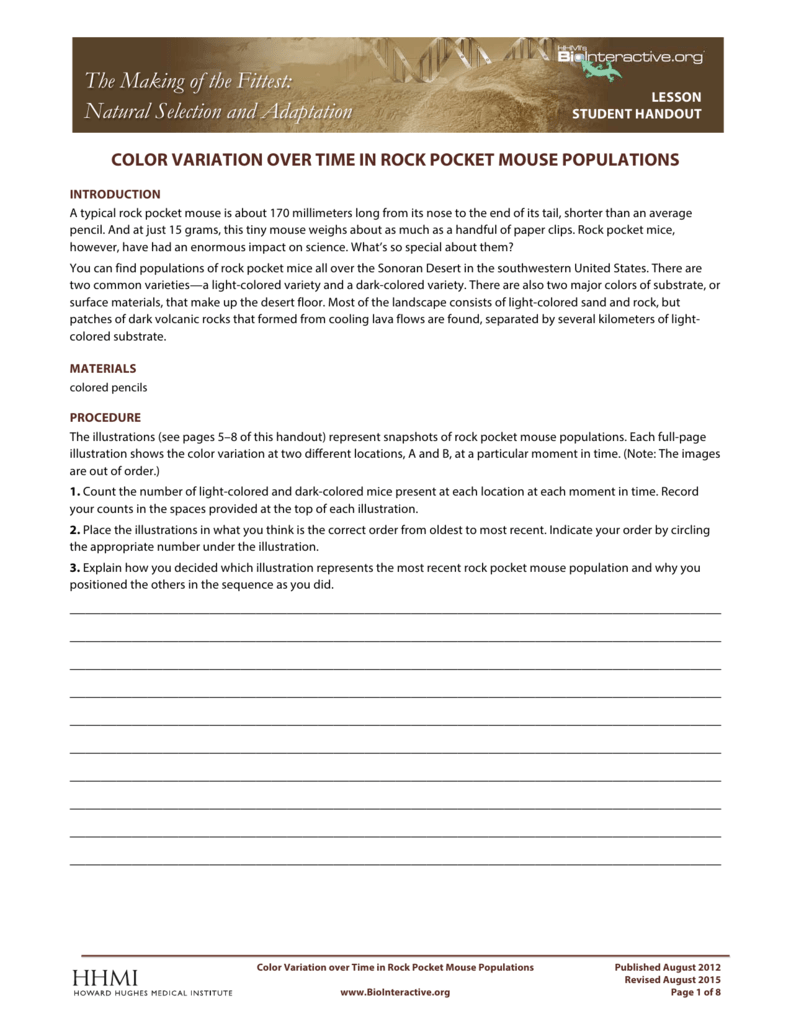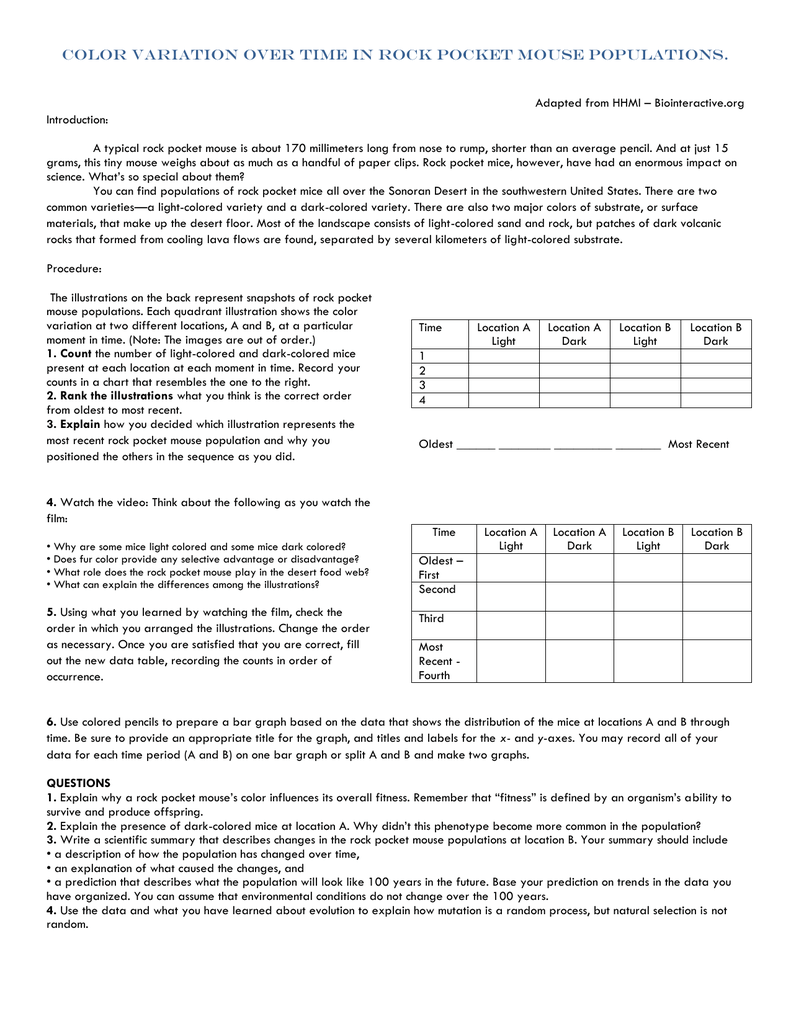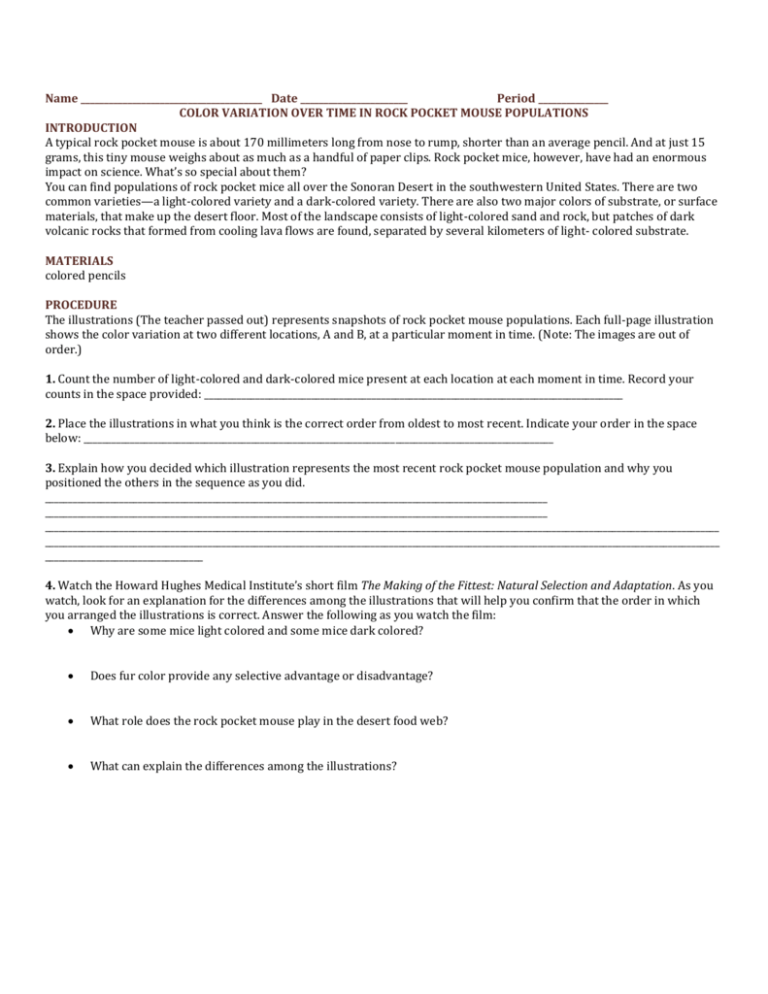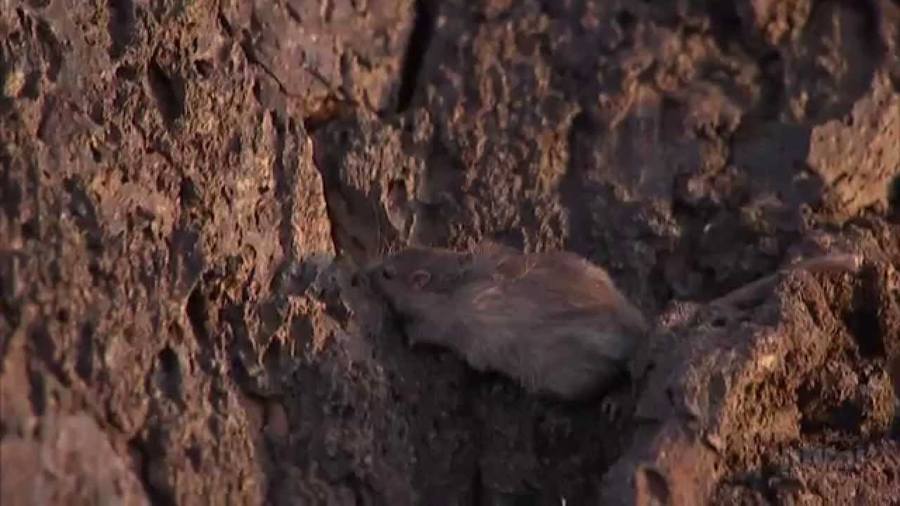
Color Variation Over Time in Rock Pocket Mouse Populations
means of reinforcing the concepts of variation and natural selection. If your class covers the Hardy-Weinberg equilibrium, you may wish to use the other film lesson, "Allele and Phenotype Frequencies in Rock Pocket Mouse Populations." LEARNING OBJECTIVES . Students will be able to: • explain how natural selection preserves favorable traits.

a small rodent is sitting on the ground
Color Variation over Time in Rock Pocket Mouse Populations Page 5 of 8 LESSON STUDENT HANDOUT The Making of the Fittest: Natural Selection and Adaptation 1 . 1. Color Variation over Time in Rock Pocket Mouse Populations Page 6 of 8 . LESSON STUDENT HANDOUT . The Making of the Fittest: Natural Selection and Adaptation . L. 2 .

Rock pocket mouse activity Science Lesson Activities, Life Science
11 Members Description This animation shows why different fur colors can be advantageous to mice in different environments. Rock pocket mice can have either light-colored or dark-colored fur. As shown in the animation, mice that blend in with their surroundings are harder for owls and other predators to see.

Color Variation over Time in Rock Pocket Mouse Populations
Dr. Michael Nachman, working in the field and lab, has quantified predation on rock pocket mice and identified adaptive changes in coat-color genes that allow the mice to travel under the radar of hungry predators. KEY CONCEPTS A mutation is a random change to an organism's DNA sequence.

The making of the Fittest Natural Selection and Adaptation Rock Pocket
COLOR VARIATION OVER TIME IN ROCK POCKET MOUSE POPULATIONS INTRODUCTION A typical rock pocket mouse is about 170 millimeters long from its nose to the end of its tail, shorter than an average pencil. And at just 15 grams, this tiny mouse weighs about as much as a handful of paper clips.

The Making of the Fittest Natural Selection and Adaptation
If your class does not cover Hardy-Weinberg equilibrium, you may wish to use another lesson, "Color Variation over Time in Rock Pocket Mouse Populations" (http://www.hhmi.org/biointeractive/color-variation-over-time-rock-pocket-mouse-populations). KEY CONCEPTS AND LEARNING OBJECTIVES

Color variation over time in rock pocket mouse populations fasspicy
1. The four illustrations provided by your teacher represent snapshots of rock pocket mouse populations. Each illustration shows the color variation at two different locations, A and B, at a particular moment in time. The illustrations may be out of order. Count the number of light-colored and dark-colored mice present at each location at each.

Solved The Four Illustrations Below Represent Snapshots O...
1. The four illustrations (provided by your teacher) represent snapshots of rock pocket mouse populations. Each illustration shows the color variation at two different locations, A and B, at a particular moment in time. The illustrations may be out of order. Count the number of light-colored and dark-colored mice present at each location at.

Color Variation Over Time in Rock Pocket Mouse Populations Resource
COLOR VARIATION OVER TIME IN ROCK POCKET MOUSE POPULATIONS INTRODUCTION A typical rock pocket mouse is about 170 mm long from its nose to the end of its tail, shorter than an average pencil. And at just about 15 grams, this tiny mouse weighs about as much as a handful of paper clips. Rock pocket mice, however, have had an enormous impact on.

Color Variation Over Time in Rock Pocket Mouse Populations Natural
In this inquiry-based activity, students investigate the phenomenon of fur colors in rock pocket mice to connect genotypes to phenotypes and molecular genetics to evolution. Genetics Evolution Lessons High School — General High School — AP/IB The Making of the Fittest: Natural Selection and Adaptation

Rock Pocket Mouse biology Assignment Color Variation in Rock Pocket
Molecular Genetics of Color Mutations in Rock Pocket Mice | In these activities, students transcribe and translate portions of the rock pocket mouse Mc1r gene to further explore the genetic variations responsible for different coat colors as described in the short film Making of the Fittest: Natural Selection and Adaptation.

Mouse Color Variation Over Time in Rock Pocket Mouse Populations
One 50 -minute class period. that traits are inherited and that some traits provide organisms with a greater chance to survive and reproduce. Download the Rock Pocket Mouse Illustrations file from the activity webpage.

Name Date Period COLOR VARIATION OVER TIME IN ROCK
1. The four illustrations provided by your teacher represent snapshots of rock pocket mouse populations. Each illustration shows the color variation at two different locations, A and B, at a particular moment in time. The illustrations may be out of order.

Pin on Science
This activity explores physical and genetic evolutionary changes in rock pocket mouse populations, as discussed in the short film The Making of the Fittest: Natural Selection and Adaptation. This film uses the rock pocket mouse as a living example of Darwin's process of natural selection.

Color Variation Over Time in Rock Pocket Mouse Populations Life
Color Variation Over Time in Rock Pocket Mouse Populations Activity Educator Materials OVERVIEW This activity serves to reinforce concepts of variation and natural selection presented in the BioInteractive short film The Making of the Fittest: Natural Selection and Adaptation.

Color Variation in Rock Pocket Mice Over Time (Day 1) Quizizz
[Mechanisms of evolution: Grades 9-12] Evolution results from selection acting upon genetic variation within a population. (LS4.B) [Mechanisms of evolution: Grades 9-12] There is variation within a population. (LS3.B) [Mechanisms of evolution: Grades 9-12] Natural selection acts on the variation that exists in a population. (LS4.B, LS4.C)